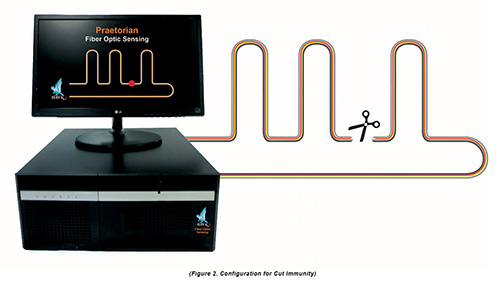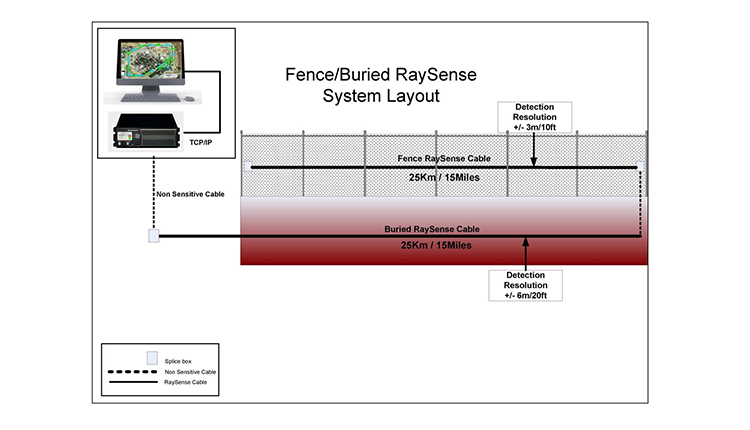How to Integrate a Fiber Optic Security System into Your Current Security Setup for Enhanced Performance
Why Fiber Optic Protection Equipments Are the Future of Defense
The transition to fiber optic security systems marks a considerable advancement in the world of protection, driven by their remarkable data transmission capabilities and strength to outside disturbances. As the landscape of protection develops alongside emerging innovations such as AI and IoT, the potential for fiber optics to enhance and redefine safety facilities comes to be progressively noticeable.
Advantages of Fiber Optic Systems
One of the key advantages of fiber optic systems is their exceptional data transfer capability, which facilitates the transmission of huge volumes of information over long ranges without considerable loss. This characteristic is particularly valuable for safety applications that call for the continuous tracking and transfer of high-def video clip feeds, sensing unit information, and various other essential info. Optical fiber can accommodate the expanding needs of modern-day safety systems, guaranteeing that data remains undamaged and trusted.
Additionally, fiber optic cords are less at risk to electro-magnetic interference, which can be a considerable concern in atmospheres with different digital devices. This resistance improves the stability of the information being sent, consequently lessening the threat of data breaches or system failings. Moreover, fiber optic systems are naturally a lot more safe and secure than conventional copper cables, as using a fiber optic line without detection is exceedingly tough.
The sturdiness of fiber optic cords additionally adds to their allure. They are immune to ecological elements such as wetness and temperature fluctuations, reducing maintenance prices and increasing system longevity. Generally, these benefits setting fiber optic systems as a durable and efficient choice for modern-day safety and security infrastructures, ensuring reputable and safe information transmission.
Enhanced Information Transmission Speed

The capability to transmit huge quantities of information rapidly promotes the seamless assimilation of high-definition video clip feeds and progressed analytics. Safety and security systems can now process and examine details in real-time, enhancing feedback times and situational understanding. Furthermore, fiber optic connections support longer transmission ranges without degradation of signal quality, making them excellent for large safety and security networks.
The enhanced rate of fiber optic systems not only enhances the effectiveness of safety procedures however also reduces latency. This is especially vital in important scenarios where timely decision-making can stop protection breaches or reduce potential dangers. As companies remain to focus on safety and efficiency, the need for fast and reputable data transmission will undoubtedly strengthen fiber optic systems as a keystone of modern safety framework.
Resistance to Disturbance
Fiber optic safety systems constantly demonstrate remarkable resistance to electro-magnetic disturbance, a crucial benefit in atmospheres prone to electronic sound. Unlike typical copper cords, which can be negatively impacted by electromagnetic fields, superhigh frequency interference, and various other types of electrical disruption, fiber optic cables use light to send data. This integral building ensures that the signals continue to be clear and unaltered, no matter bordering digital task.
The use of glass or plastic fibers in fiber optic innovation creates a barrier versus disturbance, permitting trusted data transmission even in challenging scenarios such as commercial facilities, city locations with high electronic traffic, or locations near radio towers. This particular dramatically minimizes the chance of signal destruction or loss, making fiber optic systems especially suitable for safety and security applications where integrity and precision of data are extremely important.
Furthermore, visite site this resistance to interference boosts the overall performance and integrity of security systems, ensuring that surveillance and review alert systems operate seamlessly. In a globe where safety and security is increasingly threatened by sophisticated technologies, the resilience of fiber optic systems stands out as a crucial function, strengthening their condition as an essential part of modern security framework.
Cost-Effectiveness In Time
Substantial price financial savings can be accomplished with time with the execution of fiber optic protection systems. While the first financial investment may appear higher contrasted to conventional copper-based systems, the lasting economic advantages emerge via decreased functional and maintenance expenses (fiber security). Fiber optic cables are naturally a lot more resilient and much less at risk to ecological factors, which equates to reduce replacement and repair work costs over their life expectancy
Additionally, fiber optic systems call for much less power to run, which additionally reduces energy costs. Improved data transmission capacities allow for less repeaters and amplifiers, lessening devices financial investment and improving installation processes. The scalability of these systems likewise adds to cost-effectiveness, as companies can expand their safety and security facilities without sustaining substantial extra expenditures.
Another element to think about is the increased effectiveness in tracking and feedback you could try these out capabilities that optical fiber supply. Enhanced real-time data transmission can bring about quicker occurrence response times, potentially mitigating losses and responsibilities connected with safety breaches. Altogether, the lasting benefits of fiber optic safety systems not just validate the initial expenditure however also place them as a monetarily sensible option for organizations seeking robust protection services.

Future Developments in Security
Progressing technologies are readied to change safety and security systems, incorporating expert system (AI) and artificial intelligence to boost hazard discovery and reaction abilities. These technologies will permit security systems to examine substantial amounts of information in real-time, recognizing patterns and anomalies that show potential threats. This proactive strategy will enable faster decision-making and a lot more effective incident feedbacks.
Furthermore, the incorporation of the Internet of Things (IoT) is paving the method for interconnected protection tools, using comprehensive monitoring and tracking. Smart sensors can pass on details concerning ecological changes, while automated alerts can inform protection personnel promptly of suspicious tasks.
Moreover, the evolution of biometric innovations will additionally reinforce safety and security mechanisms. Face acknowledgment, finger print scanning, and retina recognition are ending up being more sophisticated, supplying layers of authentication that are hard to bypass.
Verdict
To conclude, fiber optic safety systems represent a substantial development in defense technology, supplying unrivaled information transmission speed, resistance to electro-magnetic disturbance, and long-term cost-effectiveness. As the need for sophisticated safety remedies remains to expand, the combination of optical fiber with arising technologies such as AI, IoT, and biometrics will certainly even more improve security facilities (fiber security). The combination of these technologies will make certain an extra protected and receptive environment, strengthening optical fiber as a foundation of future security systems